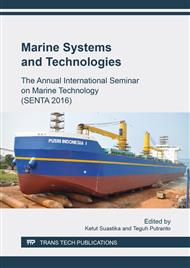p.96
p.105
p.114
p.121
p.128
p.134
p.140
p.147
p.155
Experimental Analysis on Sinking Time of Littoral Submarine in Various Trim Angle
Abstract:
A submarine must conform to Archimedes’ Principle, which states that a body immersed in a fluid has an upward force on it (buoyancy) equal to the weight of the displaced fluid, (displacement). Submarines are ships capable of being submerged. The history of submarines and their operation have largely revolved around being able to alter the density of the vessel so that it may dive below the surface, maintain a depth, and return to the surface as needed. The way modern submarines accomplish this task is to bring in and remove water from tanks in the submarine called ballast tanks. Ballast tanks fit into two categories: those used for major adjustment of mass (main ballast tanks); and those used for minor adjustments (trim tanks). The effect of each tank is plotted and this is compared with the changes in mass and trimming moment possible during operations using a trim polygon to determine whether the ballast tanks are adequate. On the water surface, metacentric height (GM) is important, whereas below the surface it is the distance between the centre of buoyancy and the centre of gravity (BG) which governs the transverse stability of a submarine.
Info:
Periodical:
Pages:
128-133
Citation:
Online since:
January 2018
Authors:
Keywords:
Price:
Сopyright:
© 2018 Trans Tech Publications Ltd. All Rights Reserved
Share:
Citation:


